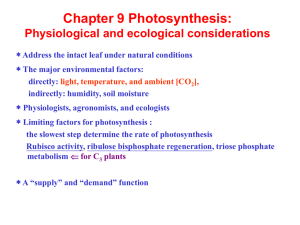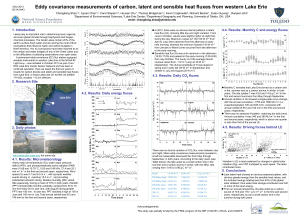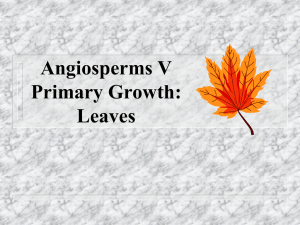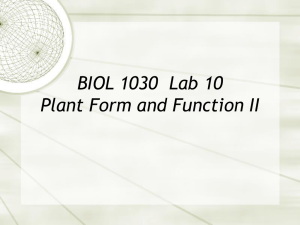Classes of Model Complexity
advertisement
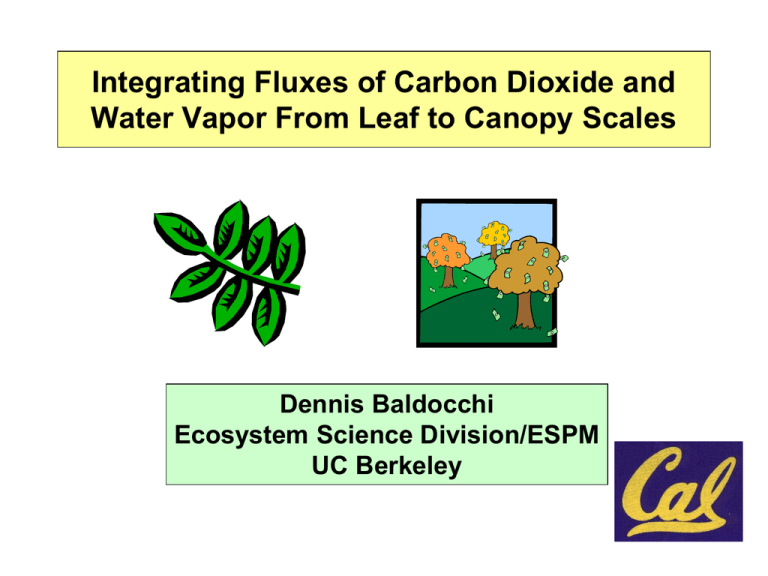
Integrating Fluxes of Carbon Dioxide and Water Vapor From Leaf to Canopy Scales Dennis Baldocchi Ecosystem Science Division/ESPM UC Berkeley Outline • Overview Leaf-Canopy Scaling and Integration Concepts • Show Tests of Such Models over Multiple Time Scales • Use the CANVEG Model to Ask Ecophysiological and Micrometeorological Questions Relating to Trace Gas Fluxes Classes of Model Complexity • The breadth and linkage of functional components that describe the biophysics of trace gas exchange. • How driving variables are defined and used as inputs to non-linear model algorithms. • The geometric abstraction of the canopy. System Complexity: Interconnection of Key Ecosystem Processes PBL ht Available Energy Transpiration/ Evaporation Sensible Heat LAI Water S Con urface duc tan ce Photosynthesis/ Respiration Carbon Litter Soil Moisture ESPM 111 Ecosystem Ecology Nutrients Processes and Linkages: Roles of Time and Space Scales continent Ecosystem Dynamics Weather model Biogeochemistry region/biome landscape Rn ppt, T a, P, e a, u,Rg,L E, H Species, Functional Type Ac,Gc Leaf Area, N/C, Ps capacity canopy Biophyscial Model Biophysical model centuries years days seconds 3-d Representation of Canopy Qi Chen and D. Baldocchi ESPM 111 Ecosystem Ecology Geometrical Abstraction of the Canopy • One-Dimensional – Big-Leaf – Dual Source, Sun-Shade – 2-Layer • Vegetation and soil – Multi-Layered • Two-Dimensional – Dual source • sunlit and shaded • Vegetated vs Bare Soil • Three-Dimensional – Individual Plants and Trees ESPM 111 Ecosystem Ecology After Hanson et al Ecol Appl 2004 Big-Leaf Model A=Rne t-G Big Leaf Model eair Tair Ra,v H E Ra,h Rc Ts fc es(Ts fc) g G 2-Layer/Dual Source Models Dual Source: Layered Model Tair H To oil G Ra,air Ra,air Ra,c Ra,s tom Ra,c E eo Ra,s oil Hs eair Rnet Tsoil Ra,s oil Rnet,soil g Rs,s oil Dual Source: Patch Model Esoil esoil es(Tsoil) Dual Source Model: Discrete Form Whole Canopy Gsfc LsunGsun LshGsh Lsun (1 exp( kL)) / k Lsh L Lsun Role of Proper Model Abstraction ESPM 111 Ecosystem Ecology Sunlit Leaf Area and Sun Angle 2.0 Lsun 1.5 1.0 0.5 G=0.5, sin=0.5 G=0.5; sin=0.75 G=0.5; sin 0.0 0 1 2 3 Leaf Area 4 5 6 Multi-Layer Models CANOAK Schematic Meteorological and Plant inputs Rg,L in, T a, q a, [CO 2], u, P, ppt, LAI, h, d,l, z o Radiative Trans fer: Qpar ,Rnir f( ) LongwaveRadiative Trans fer: f(T l,IR up ,IR dn , Stomatal Conductace= f(A,Ci,Tl, Leaf Energy Balance: H,E, T l Boundary Layer Conductace= f(u,l Leaf Photos ynthes is and Res piration: f(g s, T l,C i, g b, Q par ) Source/Sinks : ST,S q,S C Scalar Profiles : T,q,C Basics of Ecosystem Models EcoPhysiology: Leaf area index, plant functional type, photosynthetic capacity, canopy height, albedo Weather: Light Energy, Temperature, Rainfall, Humidity, Wind Velocity, CO2, soil moisture hours Physiology: Photosynthesis, Respiration, Transpiration hours/days Growth and Allocation: Leaves, Stems, Roots, Light Interception, Water and Nutrient Uptake Soil: Texture, DEM, C/ N,bulk density, Hydraulic Properties days/seasons Biogeochemistry: Decomposition, Mineralization, Nitrification, Denitrification years Ecosystem Dynamics: Reproduction, Disperal, Recruitment, Competition, Facilitation, Mortality, Disturbance ESPM 111 Ecosystem Ecology Quantifying Sources and Sinks (C(z)- Ci ) F S(C,z) = - a(z) z r b (z)+ r s (z) • Biology: a(z), Ci, rs • Physics: rb, C(z) Weight Source/Sink by Fraction of Sunlit and Shaded Leaves and Their Environment S (C, z) f ( I sun , Tsun , qsun , Csun ) psun ( z) f ( I shade , Tshade , qshade , Cshade ) pshade Random Spatial Distribution: Poisson Prob Distr. Prob of Beam Penetration LG ) P0 = exp(sin Prob of Sunlit Leaf sin dP0 LG exp() Pb = G dL sin Sources of Spatial Heterogeneity • Vertical Variations in: – Leaf area index – Leaf inclination angles – Leaf Clumping – Leaf N + photosynthetic capacity – Stomatal conductance – Light, Temperature, Wind, Humidity, CO2 Vertical Profiles in Leaf Area Deciduous Forest 30 25 Height (m) 20 15 10 5 0 0.0 0.5 1.0 2 1.5 -3 Leaf Area Density (m m ) Vertical Variation in Sunlight 0.0 30 0.5 d1411300 1.0 25 2.0 20 2.5 Height (m) Leaf Area Index 1.5 3.0 Spherical Leaf Distribution Clumped Leaf Distribution 3.5 15 10 4.0 4.5 PAR NIR 5 5.0 5.5 0 0 6.0 0.0 0.1 0.2 0.3 0.4 0.5 Pbeam(f) 0.6 0.7 0.8 0.9 1.0 20 40 60 80 100 120 Diffuse Radiation Flux density (W m-2) 140 Carboxylation Velocity Profiles D181 1200 25 Height (m) 20 15 Wc sun Wc shade Wj sun Wj shade 10 5 0 0 5 10 15 Carboxylation Velocity (mol m-2 s-1) 20 Profiles of Ci/Ca 25 Ci/Ca sunlit Height (m) 20 Ci/Ca shaded 15 10 5 0 0.65 0.70 0.75 0.80 0.85 Ci/Ca 0.90 0.95 1.00 Turbulence Closure Schemes • Lagrangian 14 12 10 8 6 Y Data 4 2 0 -2 -4 -6 -8 -10 -12 -14 -20 0 20 40 60 80 100 120 X Data • Eulerian – Zero Order, c(z)=constant – First Order, F=K dc/dz – Second Order and ++ (dc/dt, dw’c’/dt) Higher Order Closure Equations and Unknowns ESPM 228 Adv Topics Micromet & Biomet Lagrangian Near- and Far-Field Theory Far Field C profile Source Profile Total C profile C( z ) Cn ( z ) C f ( z ) ESPM 228 Adv Topics Micromet & Biomet Dispersion Matrix N ci - cr = S j ( c j ) Di, j j=1 Ci Cr Dij S j z j ESPM 228 AdvTopics Micromet & Biomet z j Turbulent Mixing 120 100 Height 80 60 40 20 0 0 20 40 60 80 Dij (s m-1) 100 120 140 Vertical Gradients in CO2 D1431100 80 Dij=f(z/L) neutral Height (m) 60 40 20 0 353.0 353.5 354.0 354.5 355.0 355.5 CO2 (ppm) 356.0 356.5 357.0 Vertical Gradients in q and T D1431100 D1431100 80 80 Height (m) Height (m) 60 Dij=f(z/L) neutral 60 40 40 20 20 0 22.6 22.8 0 0.0113 0.0114 0.0115 0.0116 0.0117 0.0118 absolute humidity (kg m-3) 0.0119 0.0120 Dij = f(z/L) 23.0 23.2 Temperature (C) neutral thermal stratification 23.4 23.6 13C Profiles 80 70 1200 hours 0100 hours Height (m) 60 50 40 30 20 10 0 340 360 380 400 420 440 460 480 500 CO2 (ppm) 80 70 Height (m) 60 50 40 30 20 10 0 3.6 3.8 4.0 4.2 4.4 13 4.6 CO2 (ppm) 4.8 5.0 5.2 5.4 CANOAK MODEL Physiology Photosynthesis Stomatal Conductance FCO2 LE H Transpiration Albedo Micrometeorology Leaf/Soil Energy Balance Radiative Transfer Lagrangian Turbulent Transfer Gsoil Examples: Non-Linear Biophysical Processes Photosynthesis aI dC A~ ; b cI e fC aA3 bA2 cA d 0 es (T ) ~ exp(T ) Transpiration aLE 2 bLE c 0 Respiration Rd ~ exp(T ) Leaf Temperature A 4 s L ~T Why Non-linearity is Important? 120 100 Y Data 80 60 Expected Value, E[f(x)] 40 20 f(<x>) 0 <x> 0 2 4 6 X Data 8 10 12 Leaf Energy Balance L R R L E H •R: is shortwave solar energy, W m-2 •L: is Longwave, terrestrial energy, W m-2 E: Latent Heat Flux Density, W m-2 •H: Sensible Heat Flux Density, W m-2 ESPM 129 Biometeorology 35 Leaf Energy Balance, Wet, Transpiring Leaf Rn H E Net Radiation is balanced by the sum of Sensible and Latent Heat exchange B B Q (1 ) R L Tl H E ESPM 129 Biometeorology 4 36 Derivation Rn H E 1: Leaf Energy Balance 2: Resistance Equations for H and E E ( mv / ma ) a g w (es ( Tl ) ea ) P H a Cp (Tl Ta ) gh es (Tl ) ea D es '(Tl Ta ) 3: Linearize T4 and es(T) E P a (mv / ma ) gw Tl 4 Ta4 4Ta3( Tl Ta ) ESPM 129 Biometeorology 37 Linearize with 1st order Taylor’s Expansion Series df f ( x ) ~ f ( x0 ) ( x x0 ) dx Tl T 4T ( Tl Ta ) 4 4 a 3 a ESPM 129 Biometeorology 38 Linearize the Saturation Vapor Pressure function es ( Tl ) es ( Ta ) es' ( Tl Ta ) des (T ) es (T )' dT e" es ( Tl ) ex ( Ta ) es' ( Tl Ta ) s ( Tl Ta )2 2 d 2 es (T ) es (T )' ' dT 2 ESPM 129 Biometeorology 39 Cc * ) min [ W c ,W j,Wp ](1- •Wc, the rate of carboxylation when ribulose bisphosphate (RuBP) is saturated • •Wj, the carboxylation rate when RuBP regeneration is limited by electron transport. ) Cc Wc : demand limited by RUBISCO saturation Wj : demand limited by RuBP regeneration by electron transport 60 Carboxylation rate (mol m-2 s-1) V c - 0.5V o =Vc (1- * 50 40 30 20 supply ~stomatal conductance (gs) 10 0 0 200 400 600 [CO2] (ppm) •Wp carboxylation rate with triose phosphate utilization ESPM 228, Advanced Topics in Micromet and Biomet Ci 800 1000 Wc = If Wc is minimal, then: V C max C c [ O2 ] + (1+ ) Cc K c Ko * * V C max( C c - ) Vc 0.5Vo Wc (1)= [ O2 ] Cc ) C c + K c(1+ Ko JCc If Wj is minimal, then Wj = 4 C c + 8 * * J( C c - * ) Vc 0.5Vo W j (1- )= 4C c +8* Cc If Wp is minimal, then Wp ESPM 228, Advanced Topics in Micromet and Biomet 3Vtpu * 1 Cc Analytical Equation for Leaf Photosynthesis Baldocchi 1994 Tree Physiology ESPM 228, Advanced Topics in Micromet and Biomet Seasonality in Vcmax 70 60 White oak -2 -1 Vcmax (mol m s ) 50 40 30 20 10 0 100 125 150 175 200 225 250 Day of year Wilson et al. 2001 Tree Physiol ESPM 228, Advanced Topics in Micromet and Biomet 275 300 325 Results and Discussion Model Test: Hourly to Annual Time Scale 1997 Walker Branch Watershed 15 measured calculated 5 -2 -1 NEE (mol m s ) 10 0 -5 -10 -15 -20 -25 0 100 200 300 400 500 600 700 b[0] 0.908 b[1] 1.085 r² 0.815 10 -2 -1 NEE computed (mol m s ) 20 0 -10 -20 -30 -30 -25 -20 -15 -10 -5 0 5 NEE measured (mol m-2 s-1) 10 15 20 Model Test: Hourly Data Temperate Deciduous Forest, 1997 400 Measured Calculated -2 LE (W m ) 300 200 100 0 0 5 10 20 25 Week 500 Coefficients: b[0]: 4.96 b[1]: 1.14 r ²: 0.83 400 -2 LE calculated (W m ) 15 300 200 100 0 0 100 200 300 LE measured (W m -2 400 ) 500 Time Scales of Interannual Variability 10 nSwc(n)/w'c' 1 1997 canoak data 0.1 0.01 0.001 0.0001 0.0001 0.001 0.01 n, cycles per hour 0.1 1 Spectra of Photosynthesis and Respiration 1 Canopy Ps Canopy Respiration nSxx(n)/x 2 0.1 0.01 0.001 0.0001 0.0001 0.001 0.01 0.1 1 Frequency (cycles per hour) 10 nSxy(n)/xy 1 Covariance: canopy photosynthesis and respiration 0.1 0.01 nSxy(n) 0.001 -nSxy(n) 0.0001 0.0001 0.001 0.01 0.1 Frequency (cycles per hour) 1 Model Test: Daily Integration calculated: -548 gC m-2 y-1 Measured: -668 gC m-2 y-1 1997 4 2 -2 -1 NEE (gC m d ) 0 -2 -4 -6 -8 -10 -12 0 100 200 300 Day -2 -1 NEE, calculated (gC m d ) 4 2 0 -2 -4 -6 -8 -10 b[0]: 0.173 b[1]: 0.918 r ²: 0.556 -12 -12 -10 -8 -6 -4 -2 0 NEE measured (gC m-2 day-1) 2 4 Interannual Variability Temperate Deciduous Forest: Canoak Net Ecosystem C Exchange (g C m-2 yr-1) -400 -450 -500 -550 CANOAK Measured and Gap-Filled -600 -650 1980 1982 1984 1986 1988 1990 Year 1992 1994 1996 1998 2000 Model Validation: Who is Right and Wrong, and Why? How Good is Good Enough? Hansen et al, 2004 Ecol Monograph ESPM 111 Ecosystem Ecology Decadal Power Spectrum of CO2 and Water Vapor Fluxes 1987-1997 Canoak Temperate Deciduous Forest 1 year 1 daily CO2 flux daily evaporation 124 days nSxx/sx2 5.6 yrs 0.1 0.01 0.0001 0.001 0.01 f (cycles per day) 0.1 1 NEE and Growing Season Length Temperate Deciduous Forests 0 -100 NEE (g C m-2 year-1) -200 -300 -400 -500 -600 CANOAK, Oak Ridge, TN Published Measurements, r2=0.89 -700 -800 120 140 160 180 200 Days with NEE < 0 220 240 GPP CANVEG EUROFLUX Walker Branch Watershed Duke: Ellsworth/Katul Metolius Young: Law et al Metolius old: Law et al Harvard: Barford et al. 1800 GPP (gC m -2 -1 yr ) 1600 1400 1200 1000 800 600 400 0 100 200 300 Vcmax LAI/fpar 400 500 Component C Fluxes 1.2 1.1 Rplant/Ps 1.0 0.9 0.8 0.7 Gifford (1994) 0.6 0.5 0.4 0 100 200 300 Vcmax*LAI/fpar 10/19/2000 Rpl = Rleaf+Rbole+1/2 Rsoil 400 500 Light Use Efficiency and Net Primary Productivity NPP=f Qp Tree Tree Tree Tree LUE and Leaf Area crop canopy Vcmax = 100 mol m-2 s-1 50 LAI=5 LAI=3 40 LAI=1 Pc (mol m-1 s-1) 30 20 10 0 -10 0 500 1000 1500 PAR (mol m-2 s-1) 2000 LUE and Ps Capacity crop canopy LAI = 5 50 Vcmax = 100 mol m-2 s-1 Vcmax = 50 40 Vcmax = 25 Pc(mol m-1 s-1) 30 20 10 0 -10 0 500 1000 1500 -2 PAR (mol m -1 s ) 2000 Emergent Processes: Impact of Leaf Clumping on Canopy Light Response Curves Deciduous forest Fc (mol m-2 s-1) -40 (a) -30 -20 -10 0 model: spherical leaves 10 0 500 1000 1500 2000 2500 -2 -1 Fc (mol m s ) -40 -30 (b) -20 -10 measured model: clumped leaves 0 10 0 500 1000 PPFD 1500 2000 (mol m-2 s-1) 2500 Role of Leaf Clumping on Annual C and H2O Fluxes Temperate Deciduous Forest -200 -1 NEE (gC m year ) -300 -2 -400 -500 Clumped Foliage Spherical Foliage -600 -700 1980 1982 1984 1986 1988 1990 1992 1994 1996 1998 2000 950 Clumped Foliage Spherical Foliage 900 -1 ET (mm year ) 850 800 750 700 650 600 1980 1982 1984 1986 1988 1990 Year 1992 1994 1996 1998 2000 Interaction between Clumping and Leaf Area Temperate Deciduous Forest 1.1 Fluxsph/Flux clp 1.0 0.9 0.8 0.7 canopy photosynthesis E NEE 0.6 0.5 0 1 2 4 3 LAI 5 6 7 How Sky Conditions Affect NEE? Temperate Broad-leaved Forest Spring 1995 (days 130 to 170) 10 Sunny days diffuse/total <= 0.3 5 Cloudy days diffuse/total >= 0.7 0 NEE (mol m-2 s-1) -5 -10 -15 -20 -25 -30 -35 -40 0 500 1000 PPFD (mol m-2 s-1) 1500 2000 0 1 /2 Pdiffuse 2 P0 cos sin d 2 LAI 0 Diffuse Radiation Beam Radiation, = pi/2 Beam Radiation, =pi/3 3 4 5 6 0.0 0.2 0.4 0.6 P0 0.8 1.0 NEEmeas / NEEstat [ - ] 1.4 A Hainich (m = 0.54 +/- 0.06, r2 = 0.61) Leinefelde (m = 0.45 +/- 0.11, r2 = 0.26) 1.2 1.0 0.8 0.6 NEEmeas / NEEstat [ - ] 1.4 Hainich (measured, m = 0.54 +/- 0.06, r2 = 0.61 Hainich (modelled, m = 0.51 +/- 0.05, r2 = 0.70 B 1.2 1.0 0.8 0.6 0.0 0.2 0.4 0.6 Rd/Rs [ - ] Knohl and Baldocchi, JGR Biogeosci 2008 0.8 1.0 Diffuse light effect (slope) [ - ] 0.5 0.4 0.3 0.2 0 2 4 6 Leaf area index [m2 m-2] Knohl and Baldocchi, 2008 JGR Biogeosci 8 10 30 A -2 -1 CO2 Flux [µmol m s ] 25 20 15 10 Canopy photosynthesis Net ecosystem exchange 5 4.4 0 8 B 4.0 3.8 4 3.6 3.4 2 Transpiration Water use efficiency 0 0.1 0.2 0.3 0.4 0.5 Rd/Rs [ - ] Knohl and Baldocchi, 2008 JGR Biogeosci 0.6 0.7 3.2 3.0 0.8 Water use efficiency -1 [µmol CO2 mmol H2O] 6 -2 -1 Transpiration [mmol m s ] 4.2 Potential Impact of Aerosols/Clouds on NEE Direct Radiation is reduced by 20%: NEE = -627 gC m-2 yr-1 Ambient Conditions: NEE= -553 gC m-2 yr-1 4 NEE (gC m -2 day-1) 2 0 -2 -4 -6 -8 -10 0 50 100 150 200 Day 250 300 350 400 Oxygen and NEE: Paleoclimates 4 NEE (gC m-2 d-1) 2 0 -2 -4 -6 LAI: 6 O2=35% : -224 gC m-2 y-1 -8 -10 0 50 100 150 200 Day 250 300 350 Do We Need to Consider Canopy Microclimate [C] Feedbacks on Fluxes? Canoak Oak Ridge, TN 1997 Ave Daily LE, q(z)= qa; T(z) = Ta 200 b[0]: -0.753 b[1]: 0.983 r ²: 0.9463 150 100 50 0 0 20 40 200 Ave Daily H, q(z)= qa; T(z) = Ta 60 80 100 120 140 160 180 200 Ave Daily LE, f(z,w) (W m-2) b[0] 2.72 b[1] 0.615 r ² 0.860 150 100 50 0 0 50 100 150 200 Ave Daily Fc, q(z)= qa; T(z) = Ta; C(z)=Ca Ave Daily H, f(z,w) (W m-2) 4 b[0] 0.0119 b[1] 0.985 r ² 0.998 2 0 -2 -4 -6 -8 -8 -6 -4 -2 0 Ave Daily Fc, f(z,w) (W m-2) 2 4 Leaf Temperature and Isoprene Emission? Temperate Broadleaved Forest Days 100 to 273 0.12 0.10 1993 1981 1982 1984 1994 1997 1995 0.08 pdf 0.06 0.04 0.02 0.00 0 10 20 Tleaf 30 40 Leaf size, CO2 and Temperature: why oak leaves are small in CA and large in TN pdf tsun ambient CO2=1500 ppm, 100 mm leaf pdf tsun small leaves 0.08 sunlit leaves, daytime Oak Ridge, TN 1997 Probability 0.06 0.04 0.02 0.00 0 10 20 Tleaf 30 40 Physiological Capacity and Leaf Temperature: Why Low Capacity Leaves Can’t Be Sunlit::or don’t leave the potted Laurel Tree in the Sun Temperate Deciduous Forest Sunlit leaves, 1997 0.08 probability density Vcmax = 73 mol m-2 s-1 Vcmax = 10 mol m-2 s-1 0.06 0.04 0.02 0.00 0 10 20 Tleaf (oC) 30 40 Below Canopy Fluxes 300 Rnet (W m-2) 250 Ponderosa Pine Forest Floor D187-205, 1996 200 150 measured calculated 100 50 0 -50 E (W m-2) 75 50 25 0 -25 200 -2 H (W m ) 150 100 50 G (W m-2) 0 150 125 100 75 50 25 0 -25 -50 -75 0 4 Figure 15 enbmod.spw 12/8/99: laieff=1.8, zlitter=0.08 8 12 Time (hours) 16 20 24 Below Canopy Fluxes and Canopy Structure and Function 0.30 0.25 QE,soil/QE 0.20 0.15 0.10 0.05 0.00 0 20 40 60 80 100 120 LAI * Vcmax 140 160 180 200 Impact of Thermal Stratification Ra=f(stability) Ra: neutral 300 250 200 150 100 50 0 -50 70 60 50 40 30 20 10 0 -2 H (W m ) -2 E (W m ) -2 Rn (W m ) Ponderos Pine Forest Floor 150 125 100 75 50 25 0 -2 G (W m ) 200 150 100 50 0 -50 0 4 8 12 Time (hours) Figure 16 enmodstb.spw 12/8/99 16 20 24 Impact of Litter Litter depth, 0.01 m litter depth, 0.02 m Ponderos Pine Forest Floor -2 H (W m ) -2 E (W m ) -2 Rn (W m ) litter depth, 0.05 m 300 250 200 150 100 50 0 -50 60 50 40 30 20 10 0 150 125 100 75 50 25 0 -2 G (W m ) 150 100 50 0 -50 0 4 8 12 Time (hours) Figure 17 enmodlit.spw 12/8/99 16 20 24 Conclusions • Biophysical Models that Couple Aspects of Micrometeorology, Ecophysiology and Biogeochemistry Produce Accurate and Constrained Fluxes of C and Energy, across Multiple Time Scales • Models can be used to Interpret Field Data – LUE is affected by LAI, Clumping, direct/diffuse radiation, Ps capacity – NEE is affected by length of growing season – Interactions between leaf size, Ps capacity and position help leaves avoid lethal temperatures – Below canopy fluxes are affected by T stratification and litter

